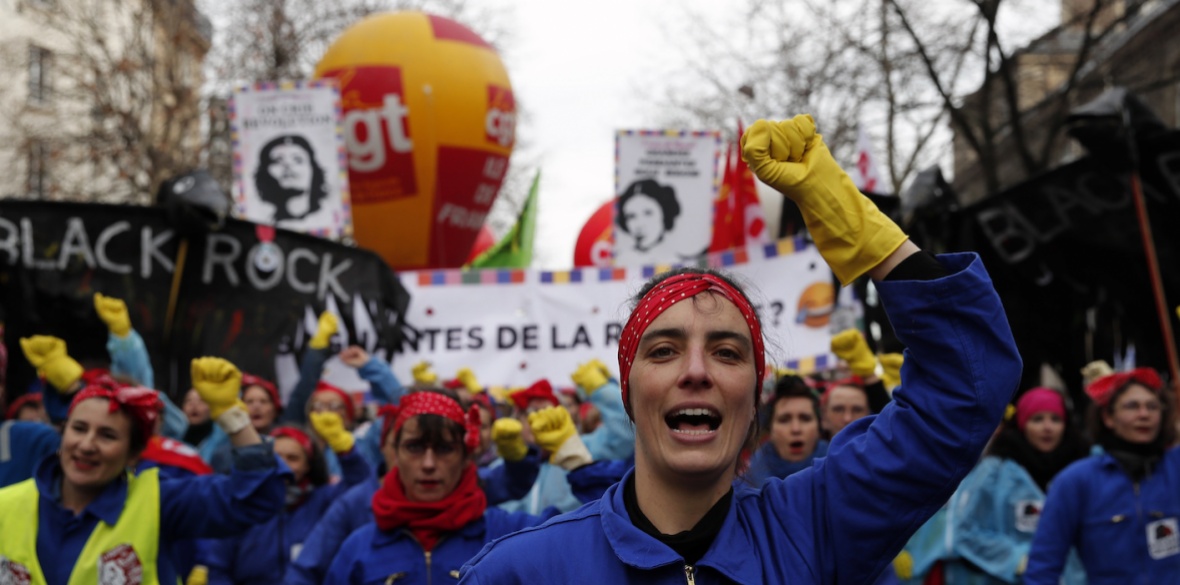This is the last article you can read this month
You can read more article this month
You can read more articles this month
Sorry your limit is up for this month
Reset on:
Please help support the Morning Star by subscribing here
PRESIDENT Emmanuel Macron’s government has blinked in its five-week standoff with the French trade unions.
It has offered to withdraw proposals to raise the retirement age from 62 to 64 if they call off strikes.
Following demonstrations that have brought as many as 800,000 people onto the streets on the biggest days, the retreat is a victory — and the CFDT and UNSA union federations have already welcomed it.
But the CGT federation is less impressed. Calling for further protests, its message to Macron this weekend was: “We’re still here.” It warns that the concession is designed to get the main body of his attack on pensions — ending dozens of collectively agreed pensions schemes and replacing them with a “universal system” of individualised pension pots — through.
For CGT activist Karl Ghazi, who addressed the Rosa Luxemburg conference in Berlin on Saturday, that can’t be allowed to happen.
“Because the future of trade unions depends in part on the outcome of this struggle.”
The huge scale and determination of the pensions strikes echoes the mobilisations of the yellow vests a year ago, and unlike those this is a mass movement organised and led by trade unions.
But Ghazi notes that the weakness of organised labour is shown up by the fact that the yellow vests still exist.
“The yellow vests rocked France, and they were the ones who compelled Macron — for the first time — to make concessions,” he told the packed-out conference hall.
Macron’s election to the French presidency was depicted as a breath of fresh air in most British media, as an emphatic endorsement of a “centrist” politics that appeared threatened by the rise of anti-Establishment parties.
The interpretation rested on ignoring inconvenient facts. Macron’s 24 per cent in the first round was a tiny lead over the fascist Marine Le Pen’s 21.3 per cent and not far ahead of the right’s Francois Fillon or the radical left’s Jean-Luc Melenchon either. (The Socialist Party candidate Benoit Hamon got a miserable 6.4 per cent, a legacy of the collapse of support for social democracy after the Francois Hollande government’s bid to push through neoliberal policies despite being elected on a left platform).
In the second round he beat Le Pen, but with just 43.61 per cent of France’s registered voters. His margin of victory was far smaller than Jacques Chirac’s against Le Pen’s father in 2002.
His economic policies weren’t new either, simply being an intensification of decades of attempts by French governments of the right and centre-left to deregulate the economy and attack workers’ rights.
France’s labour movement has resisted all these governments and often it has seen them off. Yet Ghazi is in no doubt that the trade unions are nowhere near as strong as they used to be.
“The trade union movement has been hit hard by the reorganisation of labour in France,” he says. “Since 1975 successive governments have encouraged the growth of mass unemployment, which now stands at 8.5 per cent of the workforce. This has permanently altered the balance of power against workers.
“A counteroffensive by private capital against the social gains of the postwar period has seen entire branches of industry in which trade unions were strong disappear.
“Buoyed up by victories such as that in 1995 against the last major attack on pension rights, the trade union movement did not seriously reflect on what it needed to do to win over private-sector workers who were increasingly not organised.
“Different forms of employment, especially subcontracting, have limited the effect of traditional ways of organising. Trade union actions are now often restricted to communication exercises, such as attempts to hit the brand images of companies, with mixed success.
“The decline of the two main working-class projects of the 20th century, with social democracy shifting towards liberalism and the collapse of communist perspectives with the demise of the Soviet Union, has seriously weakened class consciousness in France.”
This was the backdrop against which the yellow vests movement exploded across France in the winter of 2018-19.
“One demand, the fuel tax rise, kick started the movement. Organisation was via social networks, outside traditional organisations and often between people with no previous connexions.”
The reaction of the state was quick and brutal. By December 2 last year hundreds of yellow vests had been arrested. Police savagery during demonstrations caused some deaths and hundreds of serious injuries, many involving the loss of eyes or limbs.
The government tried to present it as a far-right movement, but “interviews and exchanges at demos made it crystal clear that this was a movement about social justice. Hostility to immigrants and anti-semitism remained marginal, atypical phenomena despite government attempts to exploit them.”
Even so, many union leaders were uncomfortable about backing a movement that had erupted against a tax rise, and others were put off by the predictable attempts by the far right to woo it.
But if reluctance to engage with the yellow vests told one story about trade union attitudes, the emergence of the movement itself “showed the complete absence of the left and labour movement from large parts of the country,” Ghazi warns.
The yellow vests still exist and demonstrate, but not in the numbers they did, and the French government no longer runs scared of them. Since December 5 French protests have been dominated by trade unions fighting against the pensions attack.
But for Ghazi it is far from clear whether this marks a serious resurgence of trade union power or a temporary uptick.
“The yellow vests show that social mobilisation is no longer carried out by the left and trade unions alone. It happens without us, and the extreme right can contest the field.”
Unions carry on with their traditional organising methods, and a universal attack on rights such as Macron’s on pensions can provoke a powerful response along those lines.
“And trade unions are still essential to protect workers. Who is better placed to lead the struggle of labour against capital? And from ecology to women’s rights and racism, unions demonstrate that they can do effective work. The workplace is the field in which oppression most directly manifests.
“But a theoretical need for unions doesn’t guarantee that they will continue to be effective actors. The state knows this, and deliberately targets the most militant unions such as CGT, with its unparalleled mobilising potential in France.
“Other union federations often fail to question liberal assumptions and logic, even though for all their moderation the government continues to decline to work with them.”
Ghazi says: “The class movement against capitalism is far from dead. The women’s movement shows it, the anti-racist movement shows it, as do the young people fighting for the future of our planet.”
But capitalism will never be seriously threatened unless opposition to it is united and speaks for the majority.
“A rapprochement between the labour movement and the yellow vests will not happen on its own. It will take serious political will. But without it it is unclear how effective we can be in future.”

 Ben Chacko
Ben Chacko









